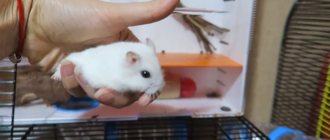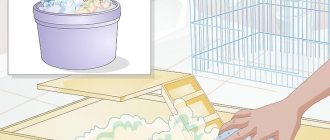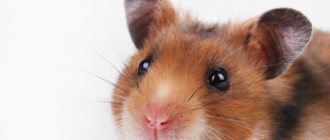Causes of aggression in hamsters
If a hamster bites, it did it for a reason. External factors provoked the animal’s aggression. Therefore, the Dzhungarik or representatives of other breeds instinctively defend themselves.
The causes of aggression and biting in a hamster are:
- The instinct of self-preservation. Pregnant or already given birth females are prone to aggression. They protect their offspring. It is not recommended to handle them or the cubs.
- The smell of food from human hands. The hamster smells a new smell and wants to know the taste. Such bites are usually shallow and isolated.
- Fright. Hamsters get scared if you suddenly grab them from above by the back. They may be in pain or scared, it is unclear what is happening. In such a case, they can bite a person repeatedly.
- Sudden movements, loud shouts or too active actions during play can frighten the rodent.
Another cause of hamster bites is tooth grinding . Their incisors and front teeth are sharp and long. Teeth grow throughout the pet's life. Therefore, it is important to ensure that the rodent has the opportunity to grind them down. For this purpose, stones and branches of some fruit trees are used. Root parts of plants, hard pieces of bread, and crackers are suitable for this.
Fear
However, sometimes even experienced owners who have owned a rodent for several months wonder why a hamster bites.
A very common reason is simple fear. Don't forget: this pet is not very smart and is quite weak. In the wild, the only way to survive in a dangerous situation is to attack a potential enemy with lightning speed. Without this habit, which became a reflex, hamsters would simply have died out many years ago. Make sure that you do not frighten the hamster or provoke it into aggression and bite. A variety of things that seem very ordinary to you can frighten him: a sharp unfamiliar sound, a changed situation (installation of a new house or wheel, changing the cage), sudden grabbing. Do not forget - each of these situations can be perceived by the hamster as critical, and he will not hesitate to use his small but very sharp teeth.
What is the danger of a hamster bite?
The likelihood of developing the disease is much greater when meeting a wild rodent. If he bites a person, the following may occur:
- rabies;
- tuberculosis of the lungs;
- listeriosis is a dangerous bacterial infection;
- toxoplasmosis is an infection of parasitic origin;
- ringworm;
- tularemia is an infection that affects the skin and lymphatic system.
The list of consequences of a hamster bite may include other diseases. Therefore, it is recommended to purchase pets from trusted places. After all, the bite of an ordinary rodent purchased at a pet store does not lead to similar consequences.
What to do if your hamster bites?
A hamster bite is not dangerous, but is not pleasant for humans. It's all about the rodent's teeth - they are sharp and thin, and at the moment of a bite they diverge in different directions, causing sharp pain. A laceration appears at the site of the lesion.
A hamster's bite should not cause a violent reaction, it is contraindicated to hit your pet and shout at it, it will not understand what is going on, but will harbor a grudge
It’s difficult to say whether it’s dangerous; what matters is how you behaved after the bite. To prevent the consequences of a hamster bite, place the rodent in a cage, wash the wound with antibacterial or laundry soap, treat with peroxide and brilliant green.
The disinfection process is very important, because bacteria can cause inflammation. There is no need to press anything from the wound. You can stick an adhesive plaster on so you can continue doing household chores - put on a finger guard.
If a child is bitten and has not been vaccinated against tetanus, get a preventive vaccination.
Symptoms of a hamster bite
Since hamsters have long and sharp teeth, the bitten area will be very painful. Depending on the depth of the puncture, a significant amount of blood may appear. Pain in the bite area for 48 hours is normal. In the future, they must pass on their own.
After a bite, you may experience an increase in temperature and mild headaches.
If blood continues to be released even after 10-12 hours, pain and dizziness do not disappear, it is recommended to consult a specialist. This indicates the development of an infection. Only doctors can cope with it.
You need to know the signs that indicate your pet has rabies. The great danger of a hamster bite is the possibility of infection with this disease. The symptoms are:
- the animal becomes aggressive and loses fear;
- when keeping several pets, the likelihood of fights and collisions increases; in other individuals, traces of deep bites, blood, and wounds are noticeable;
- the appearance of white saliva, discharge in the form of flakes from the mouth;
- refusal to drink water;
- probably eating litter, garbage and other inedible objects - this occurs on the third day from the moment of infection.
This last change in behavior is critical. It may be accompanied by intestinal perforation. At the final stage of rabies, paralysis develops. It leads to death due to suffocation or damage to the cardiovascular system and brain. Therefore, it is necessary to be aware of the symptoms of rabies in hamsters.
What to do with an infected hamster
An infected hamster usually dies within two weeks after the first symptoms of the virus appear, but if the animal’s behavior is suspicious, it is recommended to show it to a veterinarian, and he will recommend what to do with the pet. If the animal died on its own, it must be cremated by contacting a veterinary clinic, and the cage must be thoroughly cleaned. To prevent infection in the future, you should not use the same cage; it will be safer to buy a new one.
Did you know? Rabies occurs in the wild on all continents except the coldest, Antarctica. There are also no reported cases in Sweden, Portugal, Spain and Finland.
First aid and treatment after a hamster bite
In case of a strong bite (to the point of bleeding), the wound is washed and treated. At home, antiseptic agents are used: hydrogen peroxide, pale pink solution of potassium permanganate, chlorhexidine, etc. You can replace them with laundry soap. After treatment, the bitten area is covered with a plaster or bandaged.
Next, the pet is examined. This will help determine his condition and whether he has any symptoms of infection. Special attention is paid to the muzzle and belly. If they don't have them:
- swelling, partial baldness;
- purulent discharge from the eye or ear area;
- visible bite marks -
You can release the hamster into the cage, but subject to constant monitoring of it.
Symptoms of rabies after a bite may not appear for 48-72 hours .
If you are prone to allergic reactions, take antihistamines. This will avoid swelling and inflammation of the bitten area. Effective drugs: Suprastin or Tavegil.
Cases where a hamster has bitten a child until a child bleeds require special attention. Especially if it was a wild animal. It is necessary to go to the emergency room and get your child vaccinated against tetanus. This is a mandatory preventative measure. This is done in the first 12-24 hours after the hamster bite, when the incubation period has not yet ended.
Pay attention to the healing process of the damaged area. The critical ones are:
- increase in body temperature;
- changes in size and inflammation of the lymph nodes;
- pain and visual change in the bite area.
If any of these symptoms appear, you should consult a specialist. He will vaccinate and treat the bite area with antiseptics and additional compounds.
Prevention on the street
While the child is small, it is easy to cover him with a mosquito cover right in the stroller. In some cases, it is convenient to use protective clothing or tents with mosquito nets. In all other situations, repellents become almost the only protective measure. Modern repellents typically use one of these two main active ingredients - DEET or picaridin.
DEET (diethyltoluamide) is the most commonly used broad-spectrum ingredient that is effective against mosquitoes, biting flies, fleas and ticks. In most cases, a repellent containing up to 10% DEET will prevent mosquito bites. In areas at high risk of insect-borne infections (where malaria, Ross River virus, Barmah Forest virus and Dengue fever occur), repellents with a DEET concentration of 15–30% should be used.
DEET can be safely applied to cotton, wool and nylon, but can damage spandex, rayon, acetate and leather clothing. DEET can dissolve plastics and vinyl (such as sunglass frames or watch bands).
Picaridin is a new repellent ingredient that is odorless and less sticky than DEET. May be more pleasant to use, does not dissolve plastic. Studies have shown that picaridin is as effective as DEET; however, its protection is less long-lasting and it will need to be applied more frequently. Products containing 10% picaridin will prevent insect bites in most situations.
Safety of using repellents in children
Before use, read the label, assess the level of DEET or picaridin in the product, and use the repellent only as directed by the manufacturer.
Follow simple rules:
- Choose roll-on medications over aerosols if you have a choice.
- Apply a moderate amount of the drug to exposed skin.
- Do not apply the drug to cuts, wounds or irritated skin.
- Do not apply to areas around the eyes or mouth (in case of accidental contact with eyes, rinse immediately with plenty of water!).
- Do not apply to the palms or fingers of small children.
- When you return home, wash the repellent off your skin with soap and water.
- Keep repellents out of the reach of children.
- If you need to apply both sunscreen and repellent, apply the sunscreen first. Products that combine sunscreen and repellent are not recommended by experts, as sunscreen usually needs to be reapplied, but repellent does not.
Physical methods of protection
Mosquitoes are attracted to dark colors, so you should wear light-colored clothing that covers your wrists and ankles to reduce the likelihood of being bitten. If you are planning to travel to high-risk areas, it is recommended that you obtain medical advice before traveling; you may need additional vaccinations against infections and/or drugs to prevent malaria.
Stagnant water attracts mosquitoes, so stay away from dams, ponds, swamps and other areas with standing water.
To prevent mosquitoes from breeding near your home:
- Cover all water containers (including swimming pools) to prevent mosquitoes from laying eggs there.
- Empty all water containers when not in use.
- Change the water in used containers at least once a week.
- Cover cesspools and septic tanks to prevent mosquitoes from laying eggs in them.
- Remove excess vegetation from garden ponds and stock the ponds with fish.
- Avoid overwatering your garden.
How to prevent hamster aggression?
To prevent a hamster from biting a child or adult, it is recommended to take the following precautions:
- It is unacceptable to touch your pet while sleeping or eating. This can provoke instinctive aggression in him. The animal will begin to defend itself and bite the owner.
- It is not allowed to attempt to take food from a pet when it is eating or stocking up in its home.
- You should not quickly or abruptly pick up a newly acquired pet. He does not yet know that he has a new owner, and therefore with a high degree of probability he will show signs of aggression.
- The female is not disturbed during pregnancy, childbirth, or caring for babies. Intervention in these processes will provoke aggression.
To avoid unpleasant injury, games or communication are not forced on the pet.
We need to give him time to acclimatize. Then he will get used to the new conditions, owners, and surroundings. To prevent your child from getting bitten by a hamster, you need to explain to him the rules for caring for and maintaining the animal. This will prevent injury and help avoid complications.











